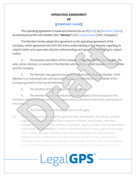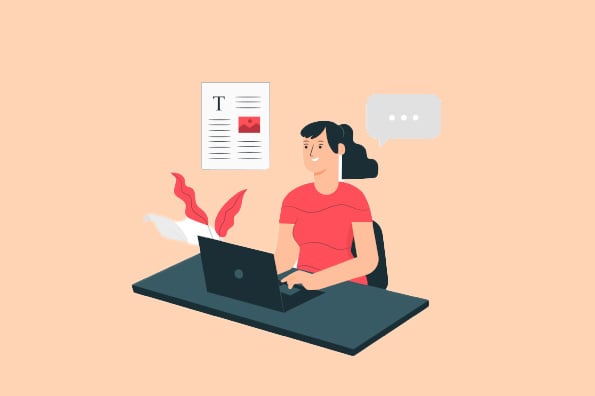Understanding Distribution Agreements: A Comprehensive Guide
If you're a business owner looking for ways to expand your business reach, entering into a distribution agreement could be just the ticket. It may...
Picture this: you’re a business owner, and you’ve just wrapped up a fantastic marketing campaign featuring your clients’ success stories. You're confident that this campaign will boost your brand image and attract new customers. But then, one of your featured clients contacts you, demanding that their image and story be removed from the campaign.
They never gave their consent, and now they're threatening legal action if you don't comply. Suddenly, your excitement turns into panic, and you're left scrambling for a solution.

Legal GPS templates are drafted by top startup attorneys and fully customizable.
This situation could have been easily avoided if you had a Media Consent and Release Form in place. As a business owner, it's vital to understand the importance of obtaining proper consent from individuals whose images, personal information, or creative contributions you plan to use in your media projects. In this blog, we'll explore the reasons why every company should utilize Media Consent and Release Forms, focusing on legal protection, privacy law compliance, building trust, and facilitating creative collaborations.

One of the most compelling reasons for using Media Consent and Release Forms is to protect your company from potential lawsuits. When you produce content that features images, videos, testimonials, or other contributions from individuals, you need to obtain their permission. Failing to do so could lead to legal disputes that can cost your business time, money, and even its reputation.
By obtaining the necessary consent through a properly drafted form, you demonstrate that you've sought and received permission to use the material, which, in turn, protects your company from potential legal claims. Media Consent and Release Forms often contain language that holds your company harmless, ensuring that the individual cannot sue you or assert claims for unauthorized use. This protection can be invaluable, especially if your business creates or relies on user-generated content.
Here's an example of how this can come into play: A company uses images of a local artist's work in a promotional video without obtaining permission. The artist sees the video and decides to sue the company for copyright infringement. Had the company secured a signed Media Consent and Release Form, they would have been protected from potential damages.
In today's increasingly connected world, privacy laws and regulations play an essential role in protecting personal information and individual rights. Businesses often need to navigate these laws to avoid potential penalties, ensuring they collect and use personal data in a manner consistent with the appropriate regulations.
Media Consent and Release Forms help companies achieve compliance by incorporating language addressing privacy requirements. For example, the EU's General Data Protection Regulation (GDPR) sets strict guidelines for collecting and processing personal data, including images and videos of individuals. By obtaining a signed consent form, companies can ensure they have obtained the necessary consent and meet GDPR requirements.
In addition, there's a growing concern over the use of biometric data, such as facial recognition technology, in media. Regulations like the Illinois Biometric Information Privacy Act (BIPA) require companies to obtain written consent before collecting, storing, or using an individual's biometric data. A Media Consent and Release Form can be adjusted to include provisions that comply with these types of regulations, further protecting your company from potential legal issues.

Protect your business with our complete legal subscription service, designed by top startup attorneys.
Beyond legal protection and privacy compliance, Media Consent and Release Forms play a pivotal role in building and maintaining trust between businesses and individuals. When individuals know that their personal information, images, and creative contributions are being used in accordance with their wishes, they're more likely to support your company and participate in future projects.
By being transparent and seeking informed consent through a Media Consent and Release Form, you demonstrate respect for individual rights, which contributes to a positive company image. This trust-building process can lead to stronger, long-lasting relationships with clients, partners, and contributors in various industries, ultimately benefiting your business.

In the world of media production and content creation, collaboration is often the key to success. Whether you're working with a team of freelancers, partnering with another business, or featuring user-generated content, having clear agreements in place can smoothen the production process.
Media Consent and Release Forms not only serve as a legal protection mechanism but also act as a valuable communication tool, ensuring that all parties understand the terms and conditions of the project. By setting expectations from the beginning and obtaining consent, you reduce the likelihood of misunderstandings, disputes, and delays, streamlining the creative process.
For example, imagine that you're organizing a photography project involving multiple models, makeup artists, and stylists. By utilizing Media Consent and Release Forms, you address each individual's rights and responsibilities, cultivating an organized and professional environment that enables everyone involved to focus on their creative contributions.
Creating a well-drafted Media Consent and Release Form can be a simple and straightforward process if you know the necessary elements to include. In this section, we'll break down the process into actionable steps and provide you with a helpful guide to draft your own form, ensuring that you protect your business while respecting the rights and privacy of individuals involved.
Begin by providing a title for the form, such as "Media Consent and Release Form." This helps distinguish the document and clarifies its purpose for both you and the individual who will be signing it.
Include essential details such as:
Name of your company
Name of the individual providing consent ("Releasor")
Date of signing
Remember to always use clear language to ensure that both parties understand the contents and purpose of the form.
Outline the specific types of media that the Releasor is giving consent for, such as photographs, videos, audio recordings, written testimonials, or any other media formats. Be as detailed as possible to avoid confusion and ensure that all relevant media are accounted for in the form.
For example, you could write:
|
Example “The Releasor hereby grants permission to the Company to use, reproduce, and redistribute any photographs, video recordings, audio recordings, and written testimonials provided by the Releasor, as well as any other materials created or contributed to by the Releasor (collectively, the "Media").” |
Clearly state the purpose for which your company will be using the Media. This might include marketing materials, promotional campaigns, website content, social media postings, or any other applicable uses. By clearly outlining how the Media will be utilized, you help ensure informed consent and protect your company from potential legal issues.
You could write something like:
|
Example “The Company may use the Media for marketing, promotional, educational, and any other lawful purposes, across all print, digital, and electronic formats, including but not limited to advertisements, brochures, articles, websites, social media, and newsletters.” |
Get Your Media Consent and Release Form Template
with a Legal GPS Subscription
In this section, the Releasor explicitly agrees to release your company from any liabilities, claims, or damages arising from the use of the Media. This is a critical part of the form, as it helps protect your business against potential lawsuits or legal disputes.
An example of this language could be:
|
Example “The Releasor hereby releases, discharges, and holds harmless the Company, its employees, agents, representatives, successors, and assigns from any and all claims, actions, demands, liabilities, damages, or costs, including attorney's fees, arising out of or resulting from the Company’s use of the Media as permitted under this agreement.” |
Specify the period for which the Releasor's consent will be valid. You can choose a fixed duration (e.g., two years) or opt for an indefinite period. It's essential to explicitly state the chosen duration to avoid potential misunderstandings.
For example:
|
Example “This consent shall remain in effect indefinitely unless explicitly revoked or terminated in writing by the Releasor.” |
In this section, you should specify the jurisdiction and governing laws that will apply in case of a dispute related to the Media Consent and Release Form. This helps ensure clarity and avoid conflicts of law if any legal disputes arise.
You might write:
|
Example “This agreement shall be governed by and construed in accordance with the laws of the State of [your state], without regard to its conflict of law provisions.” |
Finally, offer space for the Releasor to sign and print their name, affirming their consent. Make sure to include a line for the date, so it's clear when the consent was granted.
Media Consent and Release Forms are an essential aspect of any company working with media, personal information, or creative collaborations. By obtaining proper consent, your business can evade legal issues, maintain privacy law compliance, establish trust, and encourage a smooth, efficient creative process.
Don't put your company at risk by ignoring the importance of Media Consent and Release Forms. Protect your interests and respect those of the individuals you work with by implementing these essential legal documents in your business operations. Remember, prevention is always better than dealing with a crisis; therefore, stay proactive and ensure your company is covered.
We invite you to explore the Media Consent and Release Form template available on our website. It has been carefully crafted to cover all essential elements in an approachable and easy-to-use format, perfect for businesses of all sizes. Don't wait until it's too late – head over to our template page now and secure your company's legal protection with our Media Consent and Release Form.
The biggest question now is, "Do you need to hire a lawyer for help?" Sometimes, yes (especially if you have multiple owners). But often for single-owner businesses, you don't need a lawyer to start your business.
Many business owners instead use tools like Legal GPS for Business, which includes a step-by-step, interactive platform and 100+ contract templates to help you start and grow your company.
Get Legal GPS's Media Consent and Release Form Template Now

Protect your business with our complete legal subscription service, designed by top startup attorneys.

If you're a business owner looking for ways to expand your business reach, entering into a distribution agreement could be just the ticket. It may...

Welcome, entrepreneur friend! In today's world, referrals are becoming even more essential for businesses to expand their client base and increase...

As an entrepreneur, collaborating with creative professionals is an inevitable part of growing your business. Whether you're working with graphic...